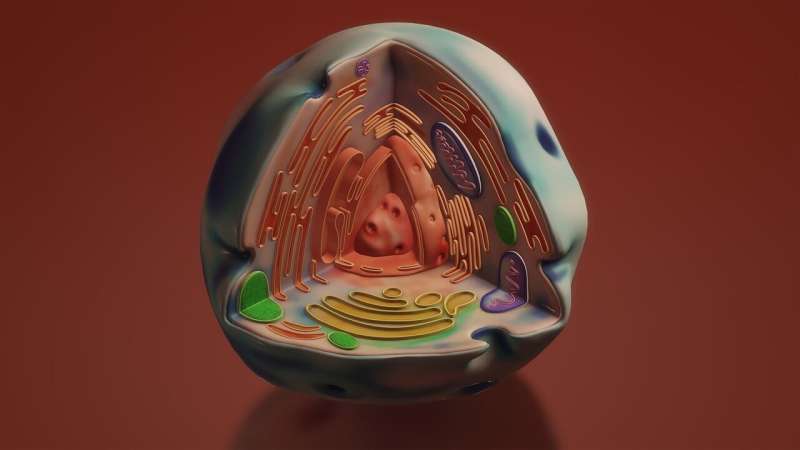This article has been reviewed according to Science X's editorial process and policies. Editors have highlighted the following attributes while ensuring the content's credibility:
fact-checked
peer-reviewed publication
trusted source
proofread
Study explains how part of the nucleolus evolved

Inside all living cells, loosely formed assemblies known as biomolecular condensates perform many critical functions. However, it is not well understood how proteins and other biomolecules come together to form these assemblies within cells.
MIT biologists have now discovered that a single scaffolding protein is responsible for the formation of one of these condensates, which forms within a cell organelle called the nucleolus. Without this protein, known as TCOF1, this condensate cannot form.
The findings could help to explain a major evolutionary shift, which took place around 300 million years ago, in how the nucleolus is organized. Until that point, the nucleolus, whose role is to help build ribosomes, was divided into two compartments. However, in amniotes (which include reptiles, birds, and mammals), the nucleolus developed a condensate that acts as a third compartment. Biologists do not yet fully understand why this shift happened.
"If you look across the tree of life, the basic structure and function of the ribosome has remained quite static; however, the process of making it keeps evolving. Our hypothesis for why this process keeps evolving is that it might make it easier to assemble ribosomes by compartmentalizing the different biochemical reactions," says Eliezer Calo, an associate professor of biology at MIT and the senior author of the study.
Now that the researchers know how this condensate, known as the fibrillar center, forms, they may be able to more easily study its function in cells. The findings also offer insight into how other condensates may have originally evolved in cells, the researchers say.
Former MIT graduate students Nima Jaberi-Lashkari Ph.D. and Byron Lee Ph.D. are the lead authors of the paper, which appears in Cell Reports. Former MIT research associate Fardin Aryan is also an author of the paper.
Condensate formation
Many cell functions are carried out by membrane-bound organelles, such as lysosomes and mitochondria, but membraneless condensates also perform critical tasks such as gene regulation and stress response. In some cases, these condensates form when needed and then dissolve when they are finished with their task.
"Almost every cellular process that is essential for the functioning of the cell has been associated somehow with condensate formation and activity," Calo says. "However, it's not very well sorted out how these condensates form."
In a 2022 study, Calo and his colleagues identified a protein region that seemed to be involved in forming condensates. In that study, the researchers used computational methods to identify and compare stretches of proteins known as low-complexity regions (LCRs), from many different species. LCRs are sequences of a single amino acid repeated many times, with a few other amino acids sprinkled in.
That work also revealed that a nucleolar protein known as TCOF1 contains many glutamate-rich LCRs that can help scaffold biomolecular assemblies.
In the new study, the researchers found that whenever TCOF1 is expressed in cells, condensates form. These condensates always include proteins usually found within a particular condensate known as the fibrillar center (FC) of the nucleolus. The FC is known to be involved in the production of ribosomal RNA, a key component of ribosomes, the cell complex responsible for building all cellular proteins.
However, despite its importance in assembling ribosomes, the fibrillar center appeared only around 300 million years ago; single-celled organisms, invertebrates, and the earliest vertebrates (fish) do not have it.
The new study suggests that TCOF1 was essential for this transition from a "bipartite" to "tripartite" nucleolus. The researchers found without TCOF1, cells form only two nucleolar compartments. Furthermore, when the researchers added TCOF1 to zebrafish embryos, which normally have bipartite nucleoli, they could induce the formation of a third compartment.
"More than just creating that condensate, TCOF1 reorganized the nucleolus to acquire tripartite properties, which indicates that whatever chemistry that condensate was bringing to the nucleolus was enough to change the composition of the organelle," Calo says.
Scaffold evolution
The researchers also found that the essential region of TCOF1 that helps it form scaffolds is the glutamate-rich low-complexity regions. These LCRs appear to interact with other glutamate-rich regions of neighboring TCOF1 molecules, helping the proteins assemble into a scaffold that can then attract other proteins and biomolecules that help form the fibrillar center.
"What's really exciting about this work is that it gives us a molecular handle to control a condensate, introduce it into a species that doesn't have it, and also get rid of it in a species that does have it. That could really help us unlock the structure-to-function relationship and figure out what is the role of the third compartment," Jaberi-Lashkari says.
Based on the findings of this study, the researchers hypothesize that cellular condensates that emerged earlier in evolutionary history may have originally been scaffolded by a single protein, as TCOF1 scaffolds the fibrillar center, but gradually evolved to become more complex.
"Our hypothesis, which is supported by the data in the paper, is that these condensates might originate from one scaffold protein that behaves as a single component, and over time, they become multicomponent," Calo says.
The formation of certain types of biomolecular condensates has also been linked to disorders such as ALS, Huntington's disease, and cancer.
"In all of these situations, what our work poses is this question of why are these assemblies forming, and what is the scaffold in these assemblies? And if we can better understand that, then I think we have a better handle on how we could treat these diseases," Lee says.
More information: Eliezer Calo, An evolutionarily nascent architecture underlying the formation and emergence of biomolecular condensates, Cell Reports (2023). DOI: 10.1016/j.celrep.2023.112955. www.cell.com/cell-reports/full … 2211-1247(23)00966-X
Journal information: Cell Reports
Provided by Massachusetts Institute of Technology





















